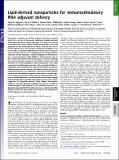| dc.contributor.author | Nguyen, David N. | |
| dc.contributor.author | Mahon, Kerry P. | |
| dc.contributor.author | Chikh, Ghania | |
| dc.contributor.author | Kim, Phillip | |
| dc.contributor.author | Chung, Hattie | |
| dc.contributor.author | Vicari, Alain P. | |
| dc.contributor.author | Love, Kevin T. | |
| dc.contributor.author | Goldberg, Michael Solomon | |
| dc.contributor.author | Chen, Steve | |
| dc.contributor.author | Krieg, Arthur M. | |
| dc.contributor.author | Chen, Jianzhu | |
| dc.contributor.author | Langer, Robert | |
| dc.contributor.author | Anderson, Daniel Griffith | |
| dc.date.accessioned | 2014-10-21T16:21:16Z | |
| dc.date.available | 2014-10-21T16:21:16Z | |
| dc.date.issued | 2012-03 | |
| dc.date.submitted | 2011-10 | |
| dc.identifier.issn | 0027-8424 | |
| dc.identifier.issn | 1091-6490 | |
| dc.identifier.uri | http://hdl.handle.net/1721.1/91044 | |
| dc.description.abstract | The specific activation of Toll-like receptors (TLRs) has potential utility for a variety of therapeutic indications including antiviral immunotherapy and as vaccine adjuvants. TLR7 and TLR 8 may be activated by their native ligands, single-stranded RNA, or by small molecules of the imidazoquinoline family. However the use of TLR7/8 agonists for in vivo therapy is limited by instability, in the case of RNA, or systemic biodistribution and toxicity in the case of small molecule agonists. We hypothesized that unique lipid-like materials, termed “lipidoids,” could be designed to efficiently deliver immunostimulatory RNA (isRNA) to TLR-expressing cells to drive innate and adaptive immune responses. A library of lipidoids was synthesized and screened for the ability to induce type I IFN activation in human peripheral blood mononuclear cells when combined with isRNA oligonucleotides. Effective lipidoid-isRNA nanoparticles, when tested in mice, stimulated strong IFN-α responses following subcutaneous injection, had robust antiviral activity that suppressed influenza virus replication, and enhanced antiovalbumin humoral and cell-mediated responses when used as a vaccine adjuvant. Further, we demonstrate that whereas all immunological activity was MyD88-dependent, certain materials were found to engage both TLR7-dependent and TLR7-independent activity in the mouse suggestive of cell-specific delivery. These lipidoid formulations, which are materials designed specifically for delivery of isRNA to Toll-like receptors, were superior to the commonly used N-[1-(2,3-dioleoyloxy)propyl]-N,N,N-trimethylammonium methylsulfate–RNA delivery system and may provide new tools for the manipulation of TLR responses in vitro and in vivo. | en_US |
| dc.description.sponsorship | National Institutes of Health (U.S.) (Grant EB00244) | en_US |
| dc.description.sponsorship | National Institutes of Health (U.S.) (Grant AI56267) | en_US |
| dc.language.iso | en_US | |
| dc.publisher | National Academy of Sciences (U.S.) | en_US |
| dc.relation.isversionof | http://dx.doi.org/10.1073/pnas.1121423109 | en_US |
| dc.rights | Article is made available in accordance with the publisher's policy and may be subject to US copyright law. Please refer to the publisher's site for terms of use. | en_US |
| dc.source | PNAS | en_US |
| dc.title | Lipid-derived nanoparticles for immunostimulatory RNA adjuvant delivery | en_US |
| dc.type | Article | en_US |
| dc.identifier.citation | Nguyen, D. N., K. P. Mahon, G. Chikh, P. Kim, H. Chung, A. P. Vicari, K. T. Love, et al. “Lipid-Derived Nanoparticles for Immunostimulatory RNA Adjuvant Delivery.” Proceedings of the National Academy of Sciences 109, no. 14 (March 15, 2012): E797–E803. | en_US |
| dc.contributor.department | Harvard University--MIT Division of Health Sciences and Technology | en_US |
| dc.contributor.department | Massachusetts Institute of Technology. Department of Biology | en_US |
| dc.contributor.department | Massachusetts Institute of Technology. Department of Chemical Engineering | en_US |
| dc.contributor.department | Koch Institute for Integrative Cancer Research at MIT | en_US |
| dc.contributor.mitauthor | Nguyen, David N. | en_US |
| dc.contributor.mitauthor | Mahon, Kerry P. | en_US |
| dc.contributor.mitauthor | Kim, Phillip | en_US |
| dc.contributor.mitauthor | Chung, Hattie | en_US |
| dc.contributor.mitauthor | Love, Kevin T. | en_US |
| dc.contributor.mitauthor | Goldberg, Michael Solomon | en_US |
| dc.contributor.mitauthor | Chen, Steve | en_US |
| dc.contributor.mitauthor | Chen, Jianzhu | en_US |
| dc.contributor.mitauthor | Langer, Robert | en_US |
| dc.contributor.mitauthor | Anderson, Daniel Griffith | en_US |
| dc.relation.journal | Proceedings of the National Academy of Sciences | en_US |
| dc.eprint.version | Final published version | en_US |
| dc.type.uri | http://purl.org/eprint/type/JournalArticle | en_US |
| eprint.status | http://purl.org/eprint/status/PeerReviewed | en_US |
| dspace.orderedauthors | Nguyen, D. N.; Mahon, K. P.; Chikh, G.; Kim, P.; Chung, H.; Vicari, A. P.; Love, K. T.; Goldberg, M.; Chen, S.; Krieg, A. M.; Chen, J.; Langer, R.; Anderson, D. G. | en_US |
| dc.identifier.orcid | https://orcid.org/0000-0001-5629-4798 | |
| dc.identifier.orcid | https://orcid.org/0000-0002-5687-6154 | |
| dc.identifier.orcid | https://orcid.org/0000-0003-4255-0492 | |
| dspace.mitauthor.error | true | |
| mit.license | PUBLISHER_POLICY | en_US |
| mit.metadata.status | Complete | |
